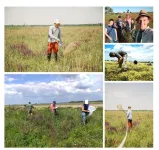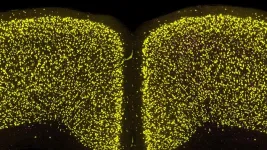(Press-News.org) With large language models that take notes during patient visits and algorithms that identify disease, artificial intelligence has begun to prove its worth as an assistant for physicians. But a new study from Stanford Medicine shows the potential of AI as a facilitator — one that helps doctors and nurses connect to achieve more efficient, effective patient care.
The study, which published in JAMA Internal Medicine last month, describes an AI-based model in use at Stanford Hospital that predicts when a patient is declining and flags the patient’s physicians and nurses. Ron Li, MD, a clinical associate professor of medicine and medical informatics director for digital health who is the senior author on the study, said the alert system helps clinicians connect more efficiently and effectively as well as intervene to prevent patients from deteriorating and landing in the intensive care unit.
Li, who worked with informatics postdoctoral scholar and lead author Robert Gallo, MD, on the evaluation, discussed their team’s approach to harnessing the algorithm and how it fosters clinician connection in a ceaselessly buzzing hospital environment. Lisa Shieh, MD, PhD, clinical professor of medicine; Margaret Smith, director of operations for primary care and population health; and Jerri Westphal, nursing informatics manager, also helped lead the study and the implementation of the AI system.
What is a deterioration model and how does AI fit in?
The algorithm is a prediction model that pulls data — such as vital signs, information from electronic health records and lab results — in near-real time to predict whether a patient in the hospital is about to suffer a health decline. Physicians aren’t able to monitor all of these data points for every patient all of the time, so the model runs in the background, looking at these values about every 15 minutes. It then uses artificial intelligence to calculate a risk score on the probability the patient is going to deteriorate, and if the patient seems like they might be declining, the model sends an alert to the care team.
What’s the benefit of having such a model run in a hospital?
The big question I want to answer is, “How do we use AI to build a more resilient health system in high-stakes situations?” There are many ways to do that, but one core characteristic for a resilient system is strong communication channels. This model is powered by AI, but the action it triggers, the intervention, is basically a conversation that otherwise may not have happened.
Nurses and physicians have conversations and handoffs when they change shifts, but it’s difficult to standardize these communication channels due to busy schedules and other hospital dynamics. The algorithm can help standardize it and draw clinicians’ attention to a patient who may need additional care. Once the alert comes into the nurse and physician simultaneously, it initiates a conversation about what the patient needs to ensure they don’t decline to the point of requiring a transfer to the ICU.
Tell me about how your team implemented and evaluated the model.
We integrated this model, which we did not create, into our workflow, but with a few tweaks. Originally, it sent an alert when the patient was already deteriorating, which we didn’t find very helpful. We adjusted the model to focus on predicting ICU transfers and other indicators of health decline.
We wanted to ensure the nursing team was heavily involved and felt empowered to initiate conversations with physicians about adjusting a patient’s care. When we evaluated the tool, which we had running for almost 10,000 patients, we saw a significant improvement in clinical outcomes — a 10.4% decrease in deterioration events, which we defined as transfers to the ICU, rapid response team events, or codes — among a subset of 963 patients with risk scores within a “regression discontinuity window,” which basically means they’re at the cusp of being high risk. These are patients whose clinical trajectory may not be as obvious to the medical team. For that group of patients, this model was especially helpful for encouraging physicians and nurses to collaborate to determine which patients need extra tending.
How have nurses and physicians responded to the integration of this new model?
The model is far from perfect. The reactions have overall been positive, but there is concern about alert fatigue, since not all alerts are flagging a real decline. When the model was validated on data from patients prior to implementation, we calculated that about 20% of patients flagged by the model did end up experiencing a deterioration event within six to 18 hours. At this point, even though it’s not a completely accurate model, it’s accurate enough to warrant a conversation. It shows that the algorithm doesn’t have to be perfect for it to be effective.
With that said, we want to improve the accuracy; you need to do that to improve trust. That’s what we’re working on now.
END
How AI improves physician and nurse collaboration
A new artificial intelligence model helps physicians and nurses work together at Stanford Hospital to boost patient care.
2024-04-16
ELSE PRESS RELEASES FROM THIS DATE:
Diverse native wildflower plantings for pollinators in farmlands
2024-04-16
Pollinators are declining rapidly, largely due to land conversion and intensification of agriculture. To mitigate their crisis, low-disturbance habitats, such as sown wildflower plantings (commonly known forms are wildflower strips at the edges of arable fields), could promote pollinators by restoration of their resources (food, sheltering and nesting habitats). However, comprehensive knowledge is lacking on how landscape context, spatial configuration and age of wildflower plantings, seasonality and flower composition affect pollinator communities, especially from East-Central Europe.
To understand these effects, researchers from the HUN-REN Centre for Ecological Research, established ...
Study suggests adolescent stress may raise risk of postpartum depression in adults
2024-04-16
In a new study, a Johns Hopkins Medicine-led research team reports that social stress during adolescence in female mice later results in prolonged elevation of the hormone cortisol after they give birth. The researchers say this corresponds to the equivalent hormonal changes in postpartum women who were exposed to adverse early life experiences — suggesting that early life stress may underlie a pathophysiological exacerbation of postpartum depression (PPD).
The team’s findings, first published online Apr. 11, 2024, in Nature Mental Health, also suggest that current drug ...
New book gathers insights, methods from rising generation of Indigenous archaeologists
2024-04-16
LAWRENCE — A book co-edited by a University of Kansas scholar that collects the experiences and know-how of younger Indigenous archaeologists, titled “Indigenizing Archaeology: Putting Theory into Practice,” is newly published by the University Press of Florida.
Carlton Shield Chief Gover, acting assistant professor of anthropology and acting assistant curator of archaeology at KU, conceived and co-edited the new volume. Its chapters include lessons and case studies from the discipline.
“This is the first book to our knowledge completely comprised of Indigenous scholars in ...
Scientists identify cell vulnerability ‘fingerprint’ related to Parkinson’s, Lewy body dementia
2024-04-16
GRAND RAPIDS, Mich. (April 16, 2024) — A new study from Van Andel Institute scientists offers a first look into the complex molecular changes that occur in brain cells with Lewy bodies, which are key pathological hallmarks of Parkinson’s disease and some dementias.
The findings, published in the journal Nature Communications, reveal that brain cells with Lewy bodies exhibit a specific gene expression pattern akin to a disease-related fingerprint.
“We’ve long known that Lewy bodies play a role in Parkinson’s and other neurodegenerative diseases but there are still many ...
Cooler transformers could help electric grid
2024-04-16
Most people do not give the U.S. electric grid a second thought — we flip a switch and the lights come on. Behind the scenes are thousands of power plants and utilities linked by millions of miles of transmission lines. And to make raw electricity useful, grid transformers convert high voltage to lower voltage that millions of households can plug into.
Transformers are aging and approaching an average of being 30 to 40 years old. Plus, they face more stress than ever before brought on by factors such as renewable energy and by extreme weather events such as hurricanes, heat waves, and winter storms. Case in point — the 2021 event in Texas that ...
Oregon State researchers advance pigment chemistry with moon-inspired reddish magentas
2024-04-16
CORVALLIS, Oregon – An Oregon State University researcher who made color history in 2009 with a vivid blue pigment has developed durable, reddish magentas inspired by lunar mineralogy and ancient Egyptian chemistry.
Mas Subramanian, distinguished professor of chemistry, and collaborators at OSU report the findings of the study, funded by the National Science Foundation, in the journal Chemistry of Materials.
The new pigments, which could be used as energy-efficient coatings for vehicles and buildings, are based on divalent chromium, Cr2+, and are ...
Conformity to masculine gender norms is linked to muscle dysmorphia among young people
2024-04-16
Toronto, ON - A new research study out of the University of Toronto sheds light on the intricate relationship between conformity to masculine gender norms and muscle dysmorphia symptomatology among a diverse sample of Canadian adolescents and young adults. The study entitled "Exploring the Association Between Conformity to Masculine Gender Norms and Muscle Dysmorphia Symptomatology in a Gender-Diverse Canadian Population" was recently published in the journal Sex Roles.
Muscle dysmorphia, characterized ...
EuBiologics’ simplified OCV achieves WHO PQ
2024-04-16
- Euvichol-S, developed jointly by EuBiologics and IVI, improves productivity by approximately 40% over Euvichol-Plus®
- Production and supply of Euvichol-S expected to help address cholera vaccine shortages
April 15, 2024, SEOUL, Republic of Korea – EuBiologics and the International Vaccine Institute (IVI) announced that Euvichol-S, an improved oral cholera vaccine (OCV) developed jointly by EuBiologics and IVI, has achieved World Health Organization prequalification (PQ). Euvichol-S ...
GPT-4 matches radiologists in detecting errors in radiology reports
2024-04-16
OAK BROOK, Ill. – Large language model GPT-4 matched the performance of radiologists in detecting errors in radiology reports, according to research published today in Radiology, a journal of the Radiological Society of North America (RSNA).
Errors in radiology reports may occur due to resident-to-attending discrepancies, speech recognition inaccuracies and high workload. Large language models, such as GPT-4, have the potential to enhance the report generation process.
“Our research offers a novel examination of the potential of OpenAI’s GPT-4,” said study lead author Roman J. Gertz, M.D., resident in the Department ...
SwRI to discuss automotive decarbonization, automation at SAE International’s WCX™ 2024
2024-04-16
SAN ANTONIO — August 16, 2024 —Southwest Research Institute helps the automotive industry transition to smart, sustainable mobility, developing hybrid, electric and hydrogen solutions and applying artificial intelligence for safe, eco-friendly driving. SwRI engineers will be in Detroit April 16-18 to share their expertise at the 2024 SAE International WCX™ World Congress Experience.
WCX invites mechanical, electrical and software engineers working in mobility from around the world to share new knowledge and advancements.
“The automotive and transportation sectors are going through tremendous change and challenges as they navigate ...
LAST 30 PRESS RELEASES:
How do childcare tax credits affect children’s long-term health?
Can an electronic nose detect indoor mold?
Do natural disasters have long-term impacts on mortality in older adults?
Modification improves sodium‐ion batteries as an alternative to lithium-ion batteries
Parasports provide a range of benefits for people with cerebral palsy
How does grandparental care affect children’s health?
Why are there so many Nordic mediators?
Young shark species more vulnerable to extinction
Mobile fetal heart monitoring linked to fewer newborn deaths in Tanzania
Bluey’s dad offered professorial chair in archaeology at Griffith University
Beyond small data limitations: Transfer learning-enabled framework for predicting mechanical properties of aluminum matrix composites
Unveiling non-thermal catalytic origin of direct current-promoted catalysis for energy-efficient transformation of greenhouse gases to valuable chemicals
Chronic breathlessness emerging as a hidden strain on hospitals
Paleontologists find first fossil bee nests made inside fossil bones
These fossils were the perfect home for ancient baby bees
Not everyone reads the room the same. A new study examines why.
New research identifies linked energy, immune and vascular changes in ME/CFS
Concurrent frailty + depression likely boost dementia risk in older people
Living in substandard housing linked to kids’ missed schooling and poor grades
Little awareness of medical + psychological complexities of steroid cream withdrawal
Eight in 10 trusts caring for emergency department patients in corridors, finds BMJ investigation
NASA’s Webb telescope finds bizarre atmosphere on a lemon-shaped exoplanet
The gut bacteria that put the brakes on weight gain in mice
Exploring how patients feel about AI transcription
Category ‘6’ tropical cyclone hot spots are growing
Video: Drivers struggle to multitask when using dashboard touch screens, study finds
SLU research shows surge in alcohol-related liver disease driving ‘deaths of despair’
Rising heat reshapes how microbes break down microplastics, new review finds
Roots reveal a hidden carbon pathway in maize plants
Membrane magic: FAMU-FSU researchers repurpose fuel cells membranes for new applications
[Press-News.org] How AI improves physician and nurse collaborationA new artificial intelligence model helps physicians and nurses work together at Stanford Hospital to boost patient care.






